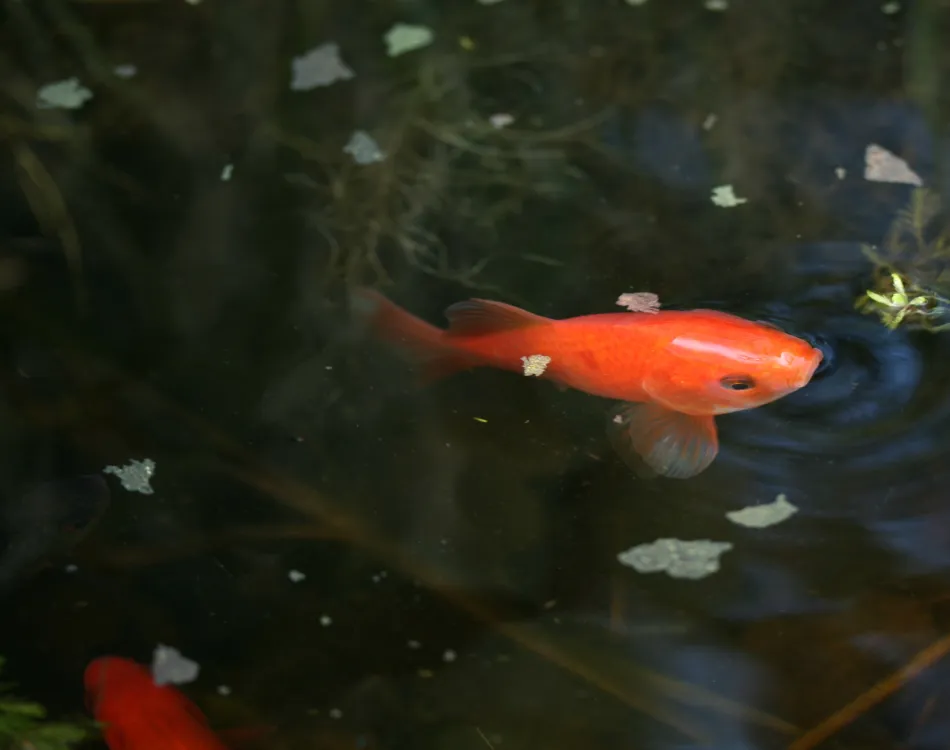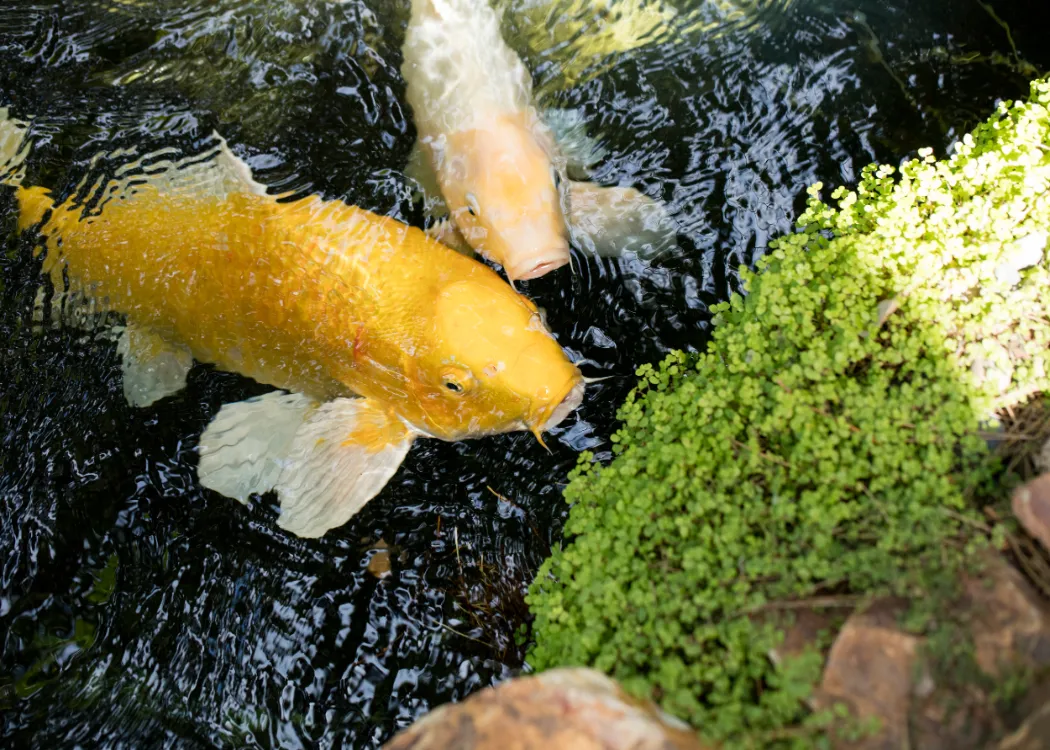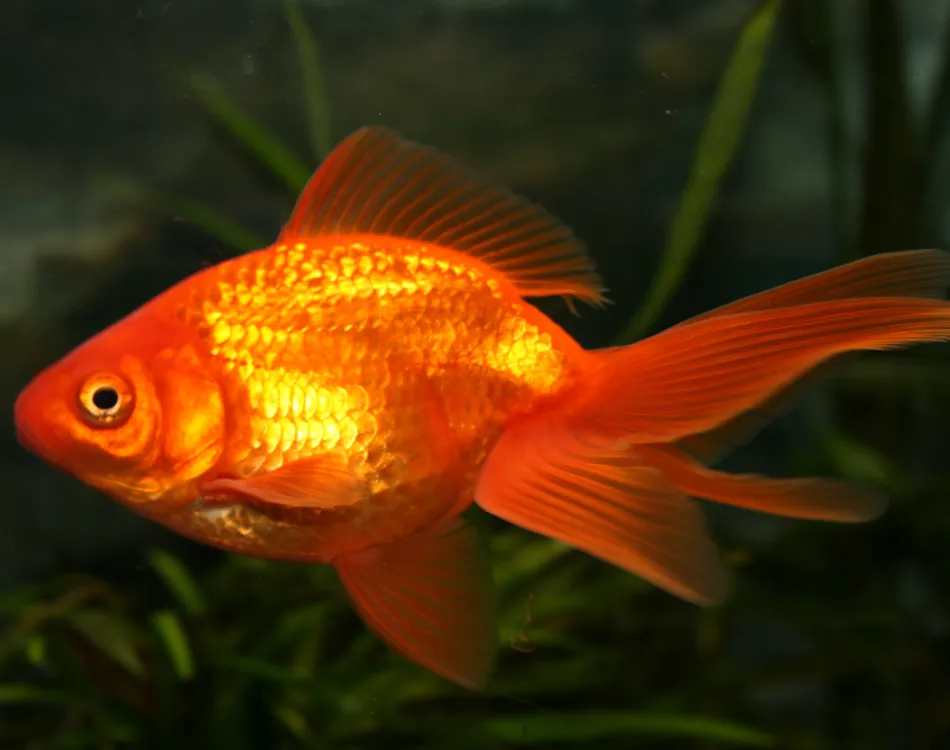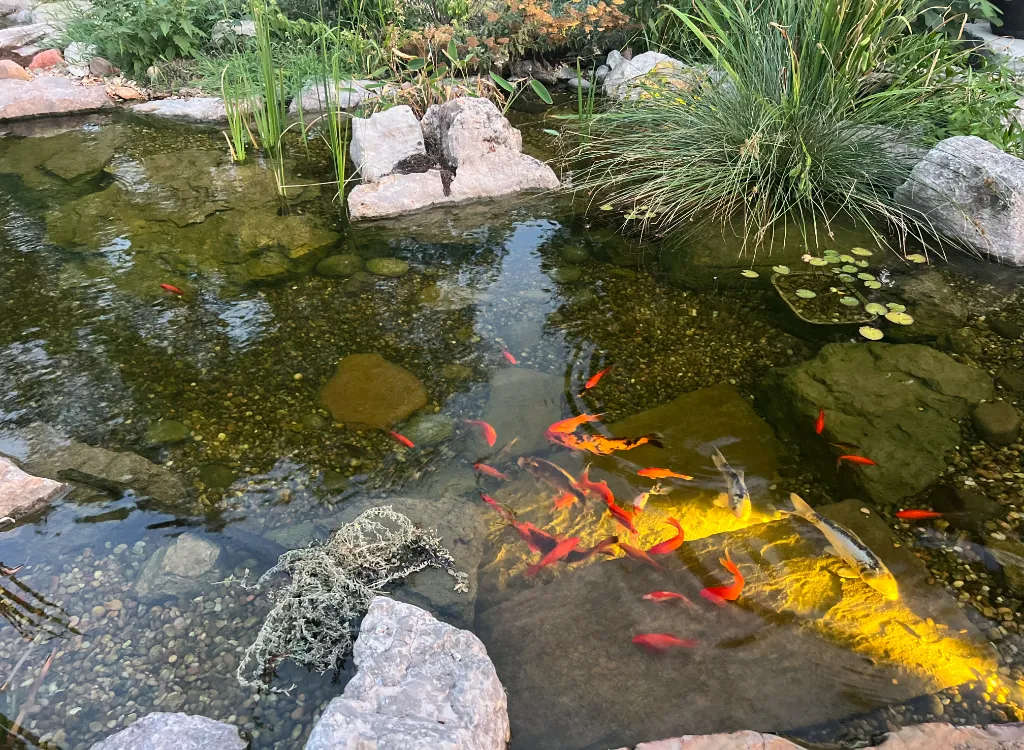
Are you a proud homeowner of a pond? Have you been wondering what to feed your fish?
In this blog post, we’re breaking down the specifics of what exactly fish eat. Understanding what fish eat and how to provide balanced nutrition is key to keeping them happy and healthy. You’ll want to know what koi fish eat specifically if you have them.
Read on to get all the information needed to create a feeding plan tailored specifically for your finned friends!
*This post is for freshwater fish found in ponds, not aquarium fish.
What Foods Do Fish Like To Eat?
When choosing food for your pond fish, it is important to remember that each species has its own dietary needs. Different types of fish should be fed different types of food depending on their size and activity level. Diets can even be slightly different among the types of koi fish.
That said, some general food categories are beneficial for most pond fish. These include live foods like worms and shrimp, frozen foods like brine shrimp or krill, pellet-based foods such as those made specifically for koi or goldfish, plant-based foods like lettuce or spinach, and vegetables like peas.
Many pond owners enjoy feeding their fish treats such as earthworms or mealworms.
Flake Fish Food

Flake food is a commercially available fish feed made from a mixture of plant- and animal-based ingredients like vitamins, minerals, proteins, and carbohydrates. It is usually fortified with other essential nutrients like omega-3 fatty acids and zinc.
The Benefits Of Feeding Your Pond Fish Flake Food
- It has all the essential nutrients necessary for healthy growth in pond fish.
- Flake food helps keep your pond water clean by reducing the amount of waste produced by your fish.
- Larger flakes are easier for smaller or older pond fish to eat as they do not have to use as much energy trying to chew them.
- Smaller pieces of flake make it easier for multiple types of aquatic life to feed at once without fighting over food or struggling to get enough nutrition from one mealtime.
Pelleted Fish Food
Pellets are excellent for feeding pond fish because they provide a balanced nutrient profile. They are made from a combination of high-quality ingredients such as proteins, minerals, vitamins, and other nutrients essential for maintaining good health in pond fish.
Pellets come in two main varieties—floating and sinking—that can be used depending on the type of fish you have in your pond. Floating pellets will remain at the surface, which is ideal for top-feeding species such as goldfish. Sinking pellets will slowly make their way down into the depths, making them perfect for bottom-feeding species such as koi carp.
Frozen Food, Freeze Dried Food, and Live Fish Foods
Frozen fish foods are exactly as they sound. This type of food is flash-frozen to preserve its ingredients and nutrition until it’s ready to be used. This consists of various pellets and other items such as shrimp, bloodworms, brine shrimp, daphnia, etc. Frozen fish food can be thawed out, or you can drop them in while frozen. You may want to avoid these if your fish tend to bite off more than they can chew.
Freeze-dried fish foods provide a convenient option for feeding your pond fish because they don’t require refrigeration or thawing out. This type of food typically comes in pellets or flakes designed to sink slowly so smaller fish can feed on them easily. The main downside of freeze-dried foods is that they lack some of the nutritional value found in fresh or frozen foods.
Live fish food provides the most natural diet for your pond fish because it’s closest to what they would eat in the wild. This includes small insects, larvae, earthworms, crickets, blackworms, etc. Live food can also mean feeder fish, meaning fish eaten by other fish.
Limit how often you feed live food to your fish. They often contain parasites that could harm your fish if ingested in large quantities. It’s also important to note that live food must be fed immediately after purchase; otherwise, it will spoil within a few hours.
Additional Treats For Fish

Pond fish can benefit from live foods such as worms, maggots, bloodworms, and spirulina.
Fruits and vegetables are another great way to supplement your pond fish diet. Leafy greens such as spinach and lettuce contain essential vitamins and minerals which help boost their immune systems and keep them healthy. Fruits such as apples can also provide beneficial proteins while adding an interesting new flavor to their diet!
When feeding fruits or vegetables, it is recommended that they be finely chopped before they are placed into the water so that they quickly sink to the bottom, where the fish can find them more easily.
If you’re feeling creative in the kitchen, why not try making homemade treats for your pond fish? There are plenty of recipes online for nutritious snacks made from ingredients such as oats, bran flakes, wheat germ, cooked peas, or potatoes—all things you probably already have in your pantry.
Types Of Fish Diets
Omnivorous Fish
Omnivorous species, such as koi fish, goldfish, and many other fish, will eat plant matter and smaller animals like insect larvae. To provide these types of pond fish with all their nutritional needs without having to go hunting yourself (or buying live prey), opt for specially formulated omnivore pellets that contain plant-based and animal proteins like shrimp meal and cod liver oil.
Carnivorous Fish
Carnivorous species of fish eat insects, worms, small frogs, and other small prey items found in the wild.
Herbivorous Fish
Being a herbivore means their diet consists mainly of plants such as algae wafers and spirulina flakes. You can also give your herbivorous pond fish fresh veggies like peas and lettuce leaves that are free from additives and pesticides. Make sure to rinse them well before adding them to the water to get rid of any leftover chemicals.
How Often Should You Feed Your Fish?
How often you should feed your pond fish depends on several factors, including water temperature, type of fish, and time of year. It also depends on the type of pond you have.
You don’t have to feed your fish at all if they live in an ecosystem pond. An ecosystem pond, when properly maintained, should have everything your fish need to survive. Fish in more artificial ponds will need regular feedings.
In general, it’s best to feed your fish once or twice a day. Let them eat as much as they can in about 5 minutes. Fish need different types and amounts of food based on their age and size. Bigger and older fish will need more food than smaller and younger ones.
Beware Of Overfeeding Your Fish
Overfeeding is one of the most common mistakes people make when caring for their pet fish.
Any leftover food will break down in the water, which can increase ammonia levels. This can result in dangerous bacteria growth and potential disease outbreaks among your fish population.
It’s also important to note that food that isn’t eaten will eventually sink to the bottom and decompose, creating problems with water quality.
To avoid overfeeding and its consequences, only give your fish what they need, no more and no less. Remove any uneaten food after a few minutes so that it doesn’t accumulate on the bottom of your pond.
How Do Fish Forage Or Hunt For Food?
Fish foraging behavior varies from species to species. Generally speaking, they hunt by sight or smell to detect nearby food. This can include worms or insect larvae drifting by on currents or floating at the water’s surface.
Depending on the species, foraging may involve digging up plant material from below rocks or gathering food from sediment at the bottom of ponds.
What Do Fish Eat In The Wild?

Most fish are opportunistic omnivores, meaning a fish eats whatever is readily available. In the wild, this includes vegetation such as algae, aquatic plants, and microscopic organisms like plankton.
Depending on the species, they will also feed on smaller fish, insects, and crustaceans. When possible, they will also scavenge for worms, mollusks, and other carrion.
What Do Baby Fish Eat?
Young fry (baby fish) are too small to consume most commercial food products. You will need to provide them with finely ground flakes or live foods such as daphnia or microworms.
Once they reach adulthood, you can transition them onto flake or pellet diets supplemented with other treats. It is important to give your young fish small meals multiple times a day instead of one large meal. This will help them get the nutrition they need to grow.
Create A Fish-Friendly Pond With Gradex
Now you can take better care of your fish once you build your pond and add them to their new home.
Speaking of building ponds, you can have Gradex build an incredible koi pond for you! You won’t have to put in the time and energy it takes to install one, plus you’ll enjoy the experience of working with a professional pond contractor.
Stop waiting; fill out our contact form today, and let’s get you closer to having a koi pond you’ll love.


